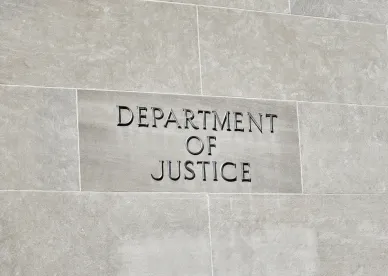Subregulatory guidance plays an important role in providing direction and insight into complex regulatory rules. The healthcare industry is highly regulated and well-versed in utilizing subregulatory guidance. This guidance often expands upon various regulatory and statutory requirements applicable to providers.
It may take the form of policy statements, opinion letters, or manuals, such as the Centers for Medicare and Medicaid Services (“CMS”) Internet-Only Manuals. Stakeholders often reference these materials in daily activities, and these materials may inform operations and compliance functions. However, subregulatory guidance may become controversial when those parties are subject to enforcement activities because such documents have not gone through formal rulemaking, and may not be controlling according to court cases.
Traditionally, the Department of Justice (“DOJ”), the federal agency charged with prosecuting fraud against the federal government, has relied on subregulatory guidance in a several ways, however in 2017 and 2018, the Trump Administration issued memoranda limiting the DOJ’s reliance on subregulatory guidance. Those memoranda added new review and approval conditions, and limited the DOJ’s publication of, and reliance on, agency guidance materials.
Shortly following his inauguration in January, President Biden issued an Executive Order instructing agencies to remove any policies that were aimed at limiting regulatory action. Accordingly, Attorney General Merrick Garland issued a memorandum on July 1, 2021 formally rescinding the DOJ 2017 and 2018 memoranda, and restoring the DOJ’s traditional approach regarding the use of, and reliance on, subregulatory guidance (the “Garland Memo”). The DOJ Justice Manual will be revised to be consistent with the Garland Memo.
The Garland Memo states that, in the enforcement context, the DOJ may rely on relevant subregulatory guidance in any “appropriate and lawful circumstances, including when a guidance document may be entitled to deference or otherwise carry persuasive weight with respect to the meaning of the applicable legal requirements.” This applies to DOJ subregulatory guidance and subregulatory guidance issued by other agencies, such as CMS. Stakeholders may expect the DOJ will cite subregulatory guidance in litigation.
The Garland Memo also announces principles governing the DOJ’s issuance and use of its own subregulatory guidance:
-
Although the DOJ’s guidance documents do not generally bind the public, the DOJ may use subregulatory guidance to outline its interpretation of binding regulations, statutes, and constitutional provisions. Stakeholders may expect subregulatory guidance to be labeled as “guidance” and provide citations to the source(s) of any binding legal requirements.
-
Internal guidance documents of the DOJ may be posted to its online portal, https://www.justice.gov/guidance. Stakeholders may expect each document to have a unique identifying numbers, and include issuance and revision dates.
-
The Office of Legal Policy in the DOJ will be working with various components to ensure all of the DOJ subregulatory guidance documents are harmoniously drafted, such that no two documents create inconsistencies.
The Garland Memo comes at a fortuitous time for law enforcement. With the barrage of government funds due to the COVID-19 pandemic, the DOJ is increasingly ramping up its enforcement efforts. Those that received Provider Relief Funds may recall that the terms and conditions of those monies, issued in the form of subregulatory guidance, were ever-changing in the early months of the pandemic. The Garland Memo allows the DOJ to site those terms and conditions, as dynamic as they were, in enforcement activities.




 />i
/>i

